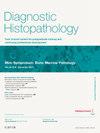乳腺转移:鉴别诊断和辅助检查指南
引用次数: 0
摘要
转移可以从乳腺外部位转移到乳房,更常见的是从乳房转移到一系列部位。在这两种情况下,准确的诊断对于确保适当的管理至关重要。虽然乳腺转移性病变占乳腺恶性肿瘤的2%,但确定主要来源对治疗具有重要意义。最常见的转移到乳房的病变包括黑色素瘤、血液系统恶性肿瘤、肺部、胃肠道和泌尿生殖系统恶性肿瘤。仔细的形态学评估可以帮助标记原发性乳腺癌的非典型特征,如缺乏原位成分或特定的细胞形态,如透明细胞改变、高细胞或高级别脱粘细胞。这些特征可以指导免疫组化(IHC)的选择,以建立诊断:免疫组化小组,以排除原发性乳腺癌,并确认替代原发性来源概述,包括“ER+陷阱”的重要性。此外,本文还概述了未知原发癌(CUP)的诊断方法。从乳房向远处转移是乳腺癌死亡的主要原因。最常见的受累部位包括骨、肺、肝和脑,但约7%的病例可能受累于皮肤和腹膜等部位。不同的乳腺癌亚型表现出向不同器官转移的不同倾向:ER+疾病经常转移到骨,而三阴性和Her2+乳腺癌更常转移到肺和脑。本文概述了用于区分转移性乳腺癌和其他转移性病变的综合免疫组化面板,强调了任何给定标记物的局限性。对于乳房的转移性病变和确定远处转移性病变的乳房起源,多学科的诊断方法是必不可少的,包括提供详细的患者病史。使用这些方法,即使在具有挑战性的病例中,也应该有可能避免诊断错误,并为患者提供最佳治疗选择。本文章由计算机程序翻译,如有差异,请以英文原文为准。
Metastasis to and from the breast: a guide to differential diagnosis and ancillary testing
Metastases can occur to the breast from extramammary sites and, more commonly, from the breast to a range of locations. In both situations, accurate diagnosis is critical to ensure appropriate management. Whilst metastatic lesions in the breast account for <2% of breast malignancies, identification of the primary source has implications for therapy. The most common lesions that metastasize to the breast include melanoma, haematological malignancies, lung, gastrointestinal and genitourinary malignancies. Careful morphological assessment can help flag features atypical for primary breast cancer, such as lack of an in-situ component or specific cellular morphology such as clear cell change, tall cells or high-grade discohesive cells. These features can guide selection of immunohistochemistry (IHC) to establish a diagnosis: panels of IHC to exclude primary breast carcinoma and confirm an alternate primary source are outlined, including the importance of the ‘ER+ trap’. Furthermore, a diagnostic approach to Carcinoma of Unknown Primary (CUP) is outlined. Metastases from the breast to distant sites are a major cause of mortality in breast cancer. The most common sites involved include bone, lung, liver and brain, though sites such as skin and peritoneum may be involved in ∼7% of cases. Different breast cancer subtypes display different propensity to metastasize to different organs: ER+ disease frequently metastasizes to bone with Triple Negative and Her2+ breast cancer more commonly spreading to lung and brain. Comprehensive IHC panels to distinguish between metastatic breast cancer and other metastatic lesions are outlined, emphasizing limitations of any given marker. For both metastatic lesions to the breast and identification of a breast origin in distant metastatic lesions, a multidisciplinary approach to diagnosis is essential, including provision of a detailed patient history. Using these approaches, it should be possible to avoid errors in diagnosis, even in challenging cases, and give the best treatment option to patients.
求助全文
通过发布文献求助,成功后即可免费获取论文全文。
去求助
来源期刊

Diagnostic Histopathology
Medicine-Pathology and Forensic Medicine
CiteScore
1.30
自引率
0.00%
发文量
64
期刊介绍:
This monthly review journal aims to provide the practising diagnostic pathologist and trainee pathologist with up-to-date reviews on histopathology and cytology and related technical advances. Each issue contains invited articles on a variety of topics from experts in the field and includes a mini-symposium exploring one subject in greater depth. Articles consist of system-based, disease-based reviews and advances in technology. They update the readers on day-to-day diagnostic work and keep them informed of important new developments. An additional feature is the short section devoted to hypotheses; these have been refereed. There is also a correspondence section.
 求助内容:
求助内容: 应助结果提醒方式:
应助结果提醒方式:


